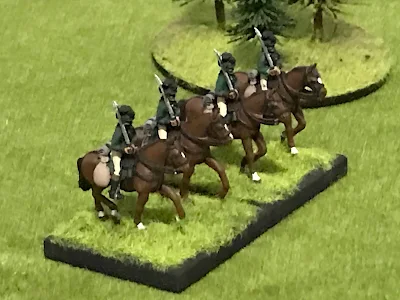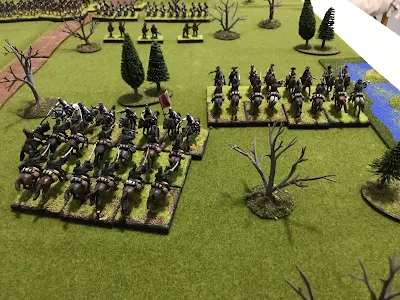 |
| Hessian Grenadier Reenactors |
One of the more interesting looking units for the American Revolution war gamer would be the combined Hessian Grenadier battalions. Made up from the detached Grenadier companies of the Hessian force sent to American they are most colorful and imposing on the table top. I am looking to add some next year so have been doing some research on them.
The treaty between Hesse Cassel and Great British determined the army sent to America would be made up of 4 Grenadier battalions, 15 Infantry battalions, 2 companies of Mayer and 2 artillery pieces and crews per regiment or battalion. Each Grenadier battalion was to have 16 Commissioned Officers, 44 Non Commissioned officers, 1 non combat officer, 20 musicians, and 429 rank and file. Actual field strength would be much lower. After the attack on Red bank the two Grenadier battalions who fought there fielded 192 men total.
Here is a field report from 1777 following the campaign to give actual field strength rather then paper strength.
Strength Report 25 November 1777
Battalion Off. NCO. Mate. D&F. R&F. Total
Linsing. 7 28 3 20 216 274
Minnigerode 6 28 3 20 217 274
Lengerke. 17 33 3 17 316 386
Kohler. 12 36 2 16 250 317
The four Grenadier battalions were made up of four companies each, and were named after their commanding officer. With slight modifications this stayed the same throughout the war.
Grenadier Battalion von Linsing
In 1776 the battalion was composed of the Grenadier company from the Leib, Mirbach, 2nd bn. Guard and 3rd bn. Guard regiments. These stated together until February 1783 when a company from the Landgraf replaced the company from the Mirbach. In May 1783 the organization changed to a company from the 1st, 2nd and 3rd bn. Guards and a company from the Erbprinz regiment.
Grenadier Battalion von Block
In 1776 it was commanded by Ltc. Justus Heinrick Block. He was replaced after that year by Ltc. George Emanuel von Lengerke. The battalion was composed if the Grenadier company from the Wutginau, Prinz Carl, Donop and Trumbach regiments. In 1783 the company from Jung von Lossberg replaced the Trumbach company.
Grenadier Battalion von Minnigerode
In 1776 the battalion was commander by Col. Frederick Ludwig von Minnigerode. He was replaced in 1780 by Col. Wilhelm von Lowenstein. The battalion was made up of the Grenadier company from the Erbprinz, Ditfurth, Lossberg and Knyphausen regiments.
Grenadier Battalion von Kohler
In 1776 commanded by Ltc. Johann Christopher Kohler. He was replaced in 1778 by Maj. Wilhelm Graf, who was replaced in 1782 by Maj. Fredrick Platte. The battalion was made up if the company from the Rall , Wissenbach, Stein and Bunau regiments.
 |
| Hessian Reenactors |
For more information please see:
The Hessian Grenadier Battalions in North America, 1776-1783"
Weinmeister, Oscar K., Jr.
MCH, 27 (Winter 1975), pp. 148-152.







































